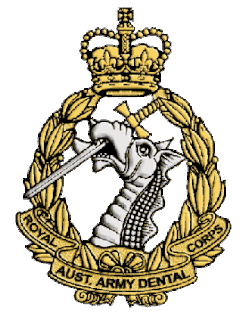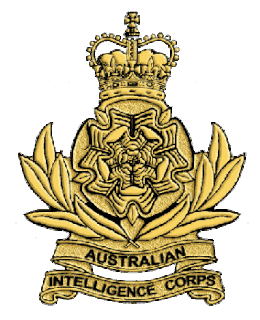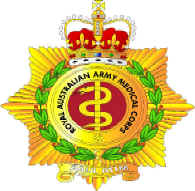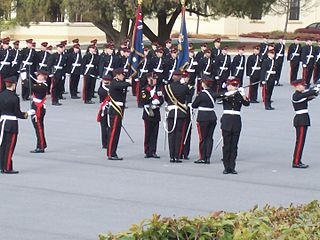 W
WThe Royal Australian Armoured Corps (RAAC) is a corps of the Australian Army which provides the Australian Defence Force's armour capability. Armour combines firepower, mobility, protection and networked situational awareness to generate shock action and overmatch in close combat. Armour is an essential element of the combined arms approach that is employed by the Australian Army.
 W
WThe Royal Regiment of Australian Artillery, normally referred to as the Royal Australian Artillery (RAA), is a Regiment of the Australian Army descended from the original colonial artillery units prior to Australia's federation. Australia's first guns were landed from HMS Sirius and a small earthen redoubt built, near the present-day Macquarie Place, to command the approaches to Sydney Cove. The deployment of these guns represents the origins of artillery in Australia. These and subsequent defences, as well as field guns, were operated by marines and the soldiers of infantry regiments stationed in Australia. The first Royal Artillery unit arrived in Australia in 1856 and began a succession of gunner units which ended with the withdrawal of the imperial forces in 1870 resulting in the raising of the Victorian Artillery Corps in Melbourne in 1870 and the New South Wales Artillery in Sydney in 1871. The First World War saw the raising of 60 field, 20 howitzer, and two siege batteries along with the heavy and medium trench mortar batteries. Until 19 September 1962 the Australian Artillery was referred to as the 'Royal Australian Artillery', however, on this date HM Queen Elizabeth II granted the RAA the title of 'The Royal Regiment of Australian Artillery'. The Regiment today consists of Regular and Reserve units.
 W
WThe Australian Army Public Relations Service (AAPRS) was formed in 1994 from personnel of the Royal Australian Army Educational Corps, a separate corps to RAAEC.. The service provides public relations support to Australian Defence Force (ADF) operations, exercises and other activities, in Australia and overseas. It is tasked with supporting regional community relations activities through to the production of public relations product, such as video, still photography and text, in areas of operation for release in support of ADF strategic communications objectives. Personnel employed in the AAPRS include photographers, reporters and public relations officers.
 W
WAustralian Army Aviation (AAAvn) is a corps of the Australian Army. It was formed on 1 July 1968, although it has a history dating back to 1911, when the Minister of Defence at the time, Senator George Pearce, decided there should be a flying school in the Defence Department. The motto of the Australian Army Aviation corps is Vigilance.
 W
WThe Australian Army Band Corps (AABC) is the Australian Army's musical branch. It is roughly the equivalent of the Music Branch and the Corps of Army Music of the British Army. The Corps was formed on 2 August 1968 and provides the Army with musical support and seeks to improve the Army's public image. It consists of 11 individual bands; five full-time and six part-time which are located in the capital city of each state as well as the regional cities of Wagga Wagga, Townsville, and Newcastle.
 W
WThe Australian Army Catering Corps (AACC) is the corps within the Australian Army that is responsible for preparing and serving of meals. The corps was established on 12 March 1943.
 W
WThe Royal Australian Army Dental Corps (RAADC) is a corps within the Australian Army. It was formed on 23 April 1943 during World War II as the Australian Army Dental Corps, before being granted the 'Royal' prefix in 1948. Prior to its formation dentists were part of the Australian Army Medical Corps. The role of the RAADC is to provide dental care to army personnel in order to minimise the requirement for the evacuation of dental casualties, to conserve manpower and to reduce the burden of casualty evacuation. In the post-war years, the corps has provided personnel to deployments in Japan, Korea and Vietnam. It has also contributed to peace-keeping operations in Somalia, Rwanda, Bougainville and East Timor.
 W
WThe Royal Australian Engineers (RAE) is the Military engineering corps of the Australian Army. The RAE is ranked fourth in seniority of the corps of the Australian Army, behind the Staff Cadets, Armoured and Artillery Corps. The corps was formed by the amalgamation of the various colonial engineer corps of the states and territories of Australia in 1902 and since then has served in various conflicts including World War I, World War II and the Vietnam War. The corps has also served on numerous peacekeeping operations and was heavily involved in the Australian contribution to the war in Afghanistan.
 W
WThe Royal Australian Infantry Corps is the parent corps for all infantry regiments of the Australian Army. It was established on 14 December 1948, with its Royal Corps status being conferred by His Majesty King George VI. At her coronation in 1953, Queen Elizabeth II became Colonel-in-Chief of the corps. Major components of the RA Inf include the various battalions of the Royal Australian Regiment and the six state-based Reserve infantry regiments, such as the Royal New South Wales Regiment. The various Regional Force Surveillance and Special Forces units of the Army are also part of the corps. The Infantry School is located at Singleton, New South Wales, and forms part of the Combined Arms Training Centre.
 W
WThe Australian Intelligence Corps (AUSTINT) is a corps within the Australian Army. It was formed on 6 December 1907 and provides intelligence personnel in every formation headquarters in the Army. As of 2007, the corps consisted of "169 officers and 232 other ranks".
 W
WThe Royal Australian Army Medical Corps (RAAMC) is the branch of the Australian Army responsible for providing medical care to Army personnel. The AAMC was formed in 1902 through the amalgamation of medical units of the various Australian colonies and was first deployed to South Africa as a small detachment of personnel supporting the Australian Commonwealth Horse during the Second Boer War. The corps has participated in every Australian Army operation since then, including wars and peacekeeping operations. The "Royal" prefix was granted in 1948.
 W
WThe Royal Australian Corps of Military Police (RACMP) is a corps within the Australian Army. Previously known as the Australian Army Provost Corps, it was formed on 3 April 1916 as the ANZAC Provost Corps. It is responsible for battlefield traffic control, security duties, prisoner of war handling, the investigation of service offences, maintaining discipline and the running of military prisons. Its name was changed in 1918 and it was disbanded in 1920. The corps was reformed during World War II and was granted the 'Royal' prefix in 1948, adopting its current name on 4 September 1974. Camilla, Duchess of Cornwall became the first Colonel-in-Chief of the Royal Australian Corps of Military Police in November 2012.
 W
WThe Royal Australian Army Nursing Corps (RAANC) is a Corps of the Australian Army. It was formed in February 1951 from the Royal Australian Army Nursing Service. A Corps Badge was introduced in 1951 with the motto Pro Humanitate. It embraces the values of compassion and service to others, reflecting the care and dedication provided to the wounded and sick. Approval for the Corps flag was granted on 7 February 1958.
 W
WThe Royal Australian Army Ordnance Corps (RAAOC) is the Corps within the Australian Army concerned with supply and administration, as well as the demolition and disposal of explosives and salvage of battle-damaged equipment. The Corps contains clerks, operator supplies, petroleum operators, parachute riggers and ammunition technicians. Members of the Corps are nicknamed Roaches.
 W
WThe Corps of Staff Cadets (CSC) is a corps of the Australian Army. It is ranked first in the Order of Precedence ahead of the Royal Australian Armoured Corps. The CSC is the corps to which all officer trainees, known as staff cadets, who attend the Royal Military College, Duntroon are allocated once they have completed their initial stage of training in III Class, known as Initial Cadet Training. Upon completion of this training, which lasts between six and eight weeks, the successful III Class cadets are welcomed into the Corps and presented with their Corps lanyard at what is known as the "Lanyard Parade". The name of the Corps of Staff Cadets is derived from the earliest history of the College, which was set up in 1911 to train officers to fill positions in the now defunct Staff Corps. Currently, however, following graduation, the cadet is promoted to the rank of lieutenant and allocated to a combat, combat support or combat service support corps, such as the Royal Australian Infantry Corps, Royal Australian Engineers, Royal Australian Armoured Corps, Royal Australian Corps of Transport, Royal Australian Artillery, etc.
 W
WThe Royal Australian Corps of Signals (RASigs) is one of the 'arms' of the Australian Army. It is responsible for installing, maintaining, and operating all types of telecommunications equipment and information systems. The motto of the Signals Corps is Certa Cito and is translated as 'Swift and Sure', signifying the aim of the signal service – that communication be carried out with maximum speed and certainty. Like their British counterparts, the Royal Australian Corps of Signals' flag and hat badge feature Mercury, the winged messenger of the gods, affectionately referred to by members of the corps as "Jimmy".
 W
WThe Royal Australian Corps of Transport (RACT) is a corps within the Australian Army. The RACT is ranked tenth in seniority of the corps of the Australian Army, and is the most senior Logistics corps. It was formed on 1 June 1973 as an amalgamation of the Royal Australian Army Service Corps (RAASC) and Royal Australian Engineers Transportation Service. The RACT is responsible for the operation of army surface transport assets, movement control, terminal and postal services, and Army aspects of air logistic support.